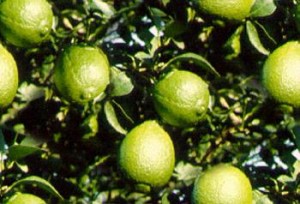Newly Purchased Lime Tree
 Question from Rachel:
Question from Rachel:
I’ve just purchased a Bearss lime tree. It’s supposed to be–eventually–a full sized tree, but right now it stands at about 6 feet. I picked it up yesterday from the nursery, constructed a wire basket for it (we’ve got gophers), and then my two children helped me get it in the ground yesterday evening. I just went out to water it and noticed that the top of the tree seems to have been clipped. The central branch–it’s very narrow, little more than a bud, so it seems too early to call it a trunk–has been snipped off. Or perhaps it broke. Either way, I took it home without noticing.
In other respects the tree seems fine. My question: is this a reason to dig the tree up and take it back to the nursery? Or will another branch assert itself as the main trunk of the tree as it grows, the way a sucker on a tomato plant will? If the tree will be fine, that’s wonderful, but I’d hate to have purchased a lime tree that had been lopped before it ever produced any fruit!
Answer from Pat:
Though I am not looking at your Bearss lime tree, I would not replace it with another just because the central leader has been headed back. By cutting a little off the top this will make the tree branch better and develop strong side branches and the evenly rounded shape natural to all citrus trees. Many people do not do not head back citrus. They prune to a central leader instead but this can create a very tall tree. There are various schools of thought on this with strong advocates on both sides.
Citrus trees grow naturally into a rounded shape like a fat ball on top of a short straight trunk. However if you look inside a full grown citrus tree, usually you will see that the trunk is about 6 or 8 feet tall and above that you will see main branches splayed out in various directions, instead of one central trunk going all the way to the top. If your tree is 6 feet tall that seems fine as a point for laterals to begin. Some branching will be lower on the trunk also.
As the tree grows and develops laterals (side branches), these laterals may sprout with tall vertical growth in waves of growth throughout the year. If you see the tree looking unbalanced and out of shape you may need to head back these vertical sprouts as well. You can accomplish this by cutting a few inches of twig off each tip so they will fatten up and branch more. This will help the tree grow strong branches and it will prevent the production of fruit way out on the tips of thin bendy growth. (Citrus trees mainly produce fruit on the ends of branches and you want these branches to be sturdy and strong so they can bear the weight of the fruit.)
After a citrus tree is full grown it will need little if any pruning other than to remove dead wood or to prevent branches from brushing the ground.
If I were you I would phone the nursery and ask if they headed your Bearss lime tree back on purpose and if so why. Make clear that your enquiry is not to be combative but just for your own information.


Pat, you are a marvel. Thank you so much for your detailed response. A little extra info, in case it matters: first, the tree is closer to 5 feet high. Here it is: You’ll notice that the central stem is arching toward the left: it was straight as an arrow when I bought it and set it into the ground. This arching is, I’m guessing, due to a bit of root shock and an increased need for water. I’m going to put a drip hose on it tonight, and expect it to perk up in a day or so.
here is the top of the tree, and here is a closeup of the top branches of the tree, with two visible cuts.
Keep well watered. Otherwise looks fine. Watering after planting a tree is as follows: Water deeply each day for 3 days, once every other day for following week, twice a week for the first month. Once a week for the next month, then lengthen watering to every two weeks or once a month or even once every 6 weeks as soil and climate requires. (In very sandy soil citrus will need deep watering every week forever; in heavy clay watering deeply once every month or six weeks is ample.)